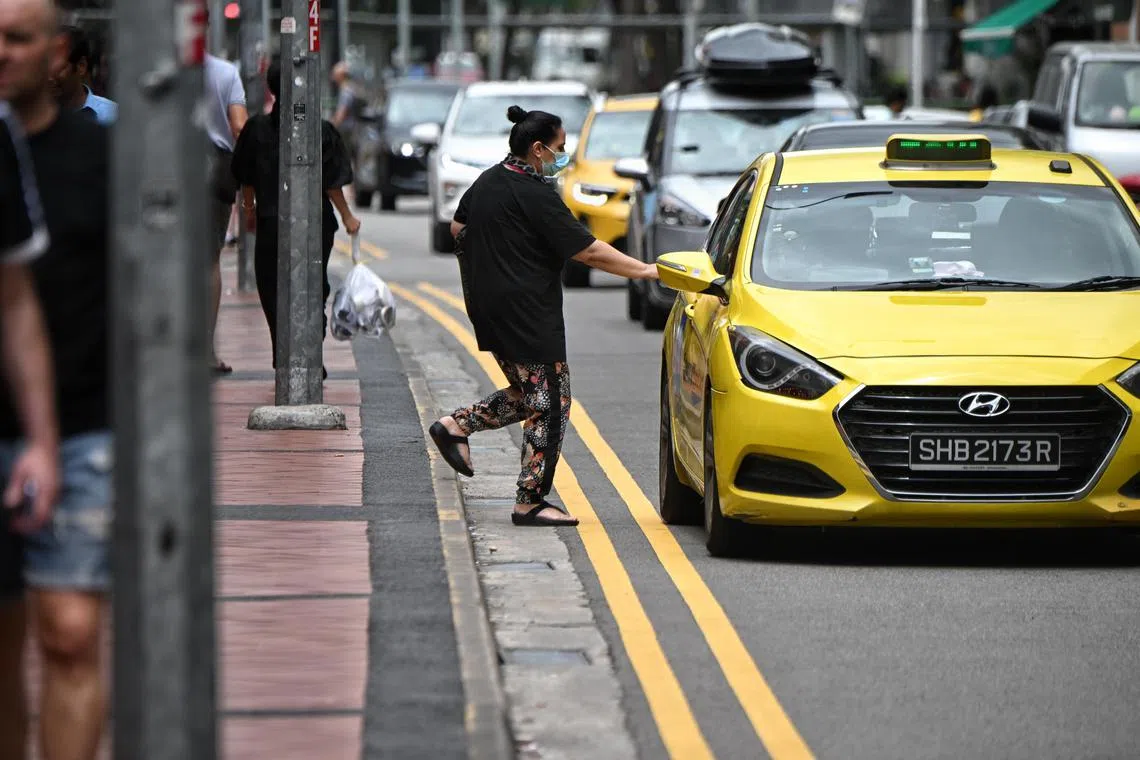Street-hail rides dwindle as Singapore’s taxi population continues to shrink
Sign up now: Get ST's newsletters delivered to your inbox

Hailing a cab used to be the most common way of getting a taxi before ride-hailing apps appeared on the scene.
PHOTO: ST FILE
Follow topic:
SINGAPORE - Sticking your arm out to flag down a taxi has become a less popular – or more difficult – method of getting a ride.
According to the latest available statistics from the Land Transport Authority (LTA), just over 12 per cent of point-to-point trips were street-hailed in November 2023, down from 22 per cent in January 2021, when the authority first started providing the segmental information.
There were 77,000 street-hailed rides a day last November, down from 129,000 in January 2021. The number of taxi trips secured by phone call bookings is estimated at 8,300 a day in 2023, from 9,100 in 2021.
The sharp drop in street hails is likely to be related to the shrinking taxi population, as only taxis are allowed to accept street hails.
LTA figures show that the number of taxis has shrunk from 15,888 in January 2021 to 13,622 in November 2023. At its peak in 2014, the cab population stood at 28,736. This was before ride-hailing firms started to grow their private-hire fleets aggressively.
The number of chauffeured private-hire cars has ballooned from 614 in 2013 to 53,448 in 2023 – an 80-fold increase in 10 years. Even so, this is slightly smaller than the pre-Covid-19 population of 55,575.
These taxi-like vehicles catered to an estimated 70 per cent of 616,000 point-to-point commutes last November, compared with around 63 per cent of the 576,000 daily rides in January 2021.
By ratio, the numbers translate to eight trips per private-hire car – or nearly 40 per cent lower than the 13 trips fulfilled by each taxi.
Mr Neo Nam Heng, chairman of diversified motor group Prime, which has taxi and private-hire cars in its portfolio, said this was because many private-hire drivers “use their vehicles as their private cars”
“There is a mismatch between supply and demand,” he added.
On street hails, Mr Neo said “they still serve a role”. “Places like the airport, zoo and shopping centres are crying out for taxis during peak. All these are considered street hail.”
Associate Professor Walter Theseira, who heads the Singapore University of Social Sciences’ urban transportation programme, said the dwindling number of street-hailed rides “leaves out a segment of both drivers and commuters”.
He noted that reasons for the shrinkage lie in the convenience of booking a ride via phone app, and drivers preferring the higher fares that ride-hailing apps tend to result in.
“Street hail ends up being less preferred by drivers when they realise metered fares are lower than booking fares,” Prof Theseira said. “So, even if passengers would prefer street hail, they won’t be able to find a vehicle.
“The market has moved towards dynamic pricing and the convenience of comparing and booking cars using apps. There is just no way for street hail to compete with that, except for commuters and drivers who don’t want to use apps,” he added.
In a survey conducted in April 2023, The Straits Times found that in spite of the wide adoption of ride-hailing phone apps, it is still possible to hail a cab from the kerb.
Commuter Elliot Lin said street-hailed rides should ideally be as readily available as app-hailed rides. “In Hong Kong, whenever I want to go somewhere, within a few minutes I’m on board a taxi and on my way,” the 39-year-old real estate agent said, adding that the fare is also predictable.
“Over here, I have to try multiple apps, wait 10 minutes or more, sometimes ‘argue’ with the driver over the pick-up point, and more often than not, before I can even book, find that the cost of the trip is two times higher than expected because of ‘dynamic’ pricing.”
According to the LTA statistics, the month with the highest total number of point-to-point trips was April 2023, when 625,000 such trips were made a day. The lowest daily number of 469,000 was recorded in July 2021, during the Covid-19 pandemic.
Meanwhile, the number of people with taxi vocational licences stood at 91,038 in November 2023, outnumbering the taxi population by 6.7 to one.
The number of drivers with private-hire vocational licences stood at 53,913, matching the private-hire car population.
Correction note: In an earlier version of the story, we said that the number of taxi trips secured by phone call bookings is estimated at 100,000 a day in 2023, up from 85,000 in 2021. This is incorrect. It should be 8,300 a day in 2023, from 9,100 in 2021.


